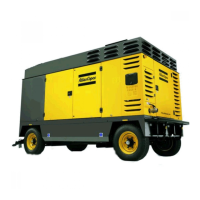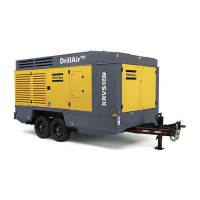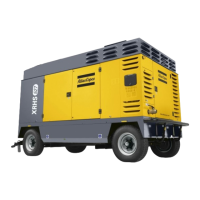Do you have a question about the Atlas Copco XRYS 577 and is the answer not in the manual?
General safety rules to follow when operating and maintaining the compressor.
Guidelines for safe transportation and installation of the compressor unit.
Essential safety measures for operating the compressor safely.
Precautions to ensure safety during maintenance and repair activities.
Guidelines for safe and effective use of tools during maintenance.
Detailed safety measures for specific components like batteries and pressure vessels.
Detailed description of the compressor models, engine, and compressor components.
Description of the air flow path through the compressor system.
Explanation of the compressor's oil system and its components.
Diagram showing the main parts of the regulating system for XRYS.
Detailed explanation of the pneumatic regulating system for specific models.
Explanation of the electronic regulating system used in XRYS models.
Description of the exhaust gas aftertreatment process and its steps.
Index of components and their references in the circuit diagrams.
Electrical circuit diagram for the engine system.
Electrical circuit diagram for the compressor system.
Diagram and description of the compressor control module.
Electrical diagrams for optional equipment.
Electrical diagrams for optional equipment.
Electrical diagrams for optional equipment.
Diagram and listing of fuses for the compressor's electrical system.
Wiring diagrams for 15-pin and 7-pin ABS trailer plugs.
Details of the wagon type undercarriage, including parking brake.
Description of the EU tandem undercarriage, its features, and transport.
Procedures for adjusting the brake system on the wagon undercarriage.
Procedures for safely parking, towing, and lifting the compressor unit.
General safety guidelines for operating the compressor.
Specific safety instructions for towing high-speed EU tandem units.
Step-by-step instructions for safely towing the compressor unit.
Procedures for safely lifting the compressor unit using appropriate equipment.
General information about the control panel and its modes.
How to set and activate pre-set times for the heater.
Steps for priming the fuel system before operation.
Procedures for starting and stopping the compressor unit.
Information regarding the battery switch and its function.
Explanation of icons used on the compressor's display.
Description of the different views available on the compressor's display.
How to start and stop the compressor using a remote control.
Instructions on using the emergency stop button for critical situations.
Actions and display for compressor shutdown due to alarms or emergency stop.
Procedures for powering off the controller and battery switch.
Details on how automatic DPF regeneration functions under various conditions.
How to inhibit DPF regeneration and its implications.
Conditions leading to increased soot load and required actions.
Instructions on how to manually initiate DPF regeneration.
Procedure for acknowledging active alarms on the display.
How to change display settings, date/time, language, and units.
How to adjust display settings like backlight.
Steps to access diagnostic menus for troubleshooting.
How to adjust the operating pressure or flow setpoint.
How to enable and configure the AutoLoad function.
Information on viewing ECU alarms and their associated SPN codes.
Information on service packs for routine maintenance tasks.
Information on service kits for specific repair or rebuilding tasks.
Critical safety measures to observe before performing maintenance.
Table detailing maintenance intervals and tasks for the compressor.
Maintenance tasks based on distance travelled (km).
How to check and top up engine oil.
How to check and top up compressor oil.
Guidelines for using the correct type of diesel fuel.
Instructions on how to top up the compressor oil level.
Detailed steps for changing compressor oil and oil filters.
Details about PARCOOL EG coolant, its benefits, and handling.
Guidelines for storing and handling PARCOOL EG coolant.
Procedures for checking coolant appearance, pH, and glycol concentration.
Instructions on how to top up or replace the coolant.
Method for topping up coolant without draining the system.
Method for topping up coolant after draining a small quantity.
Procedure for activating a dry-charged battery.
Instructions for safely recharging a battery.
Information on adding distilled water to batteries.
Detailed steps for adjusting the pneumatic regulating system for single and dual pressure.
How to clean the dust trap of the air filters.
Steps for replacing air filter elements and safety cartridges.
Steps for priming the fuel system for correct operation.
Steps for adjusting the parking brake linkage on the wagon.
How to test the effectiveness of the parking brake.
Lubrication and inspection of the towing eye.
Lubrication points for the support legs.
Lubrication points for the folding supports.
Troubleshooting steps for low compressor capacity or pressure.
Troubleshooting for high receiver pressure and safety valve activation.
Troubleshooting for unexpected unit shutdown.
Troubleshooting for air and oil mist exiting air filters after stopping.
Troubleshooting steps for compressor overheating issues.
Important safety precautions related to the alternator.
Troubleshooting for a compressor that is constantly braked.
Troubleshooting for issues where the brake cannot be released.
Troubleshooting for the service brake not releasing.
Troubleshooting for the compressor pulling to one side during driving.
Troubleshooting for sudden swerving of the compressor during driving.
Troubleshooting for flapping noises during compressor movement.
Troubleshooting for a stuck or difficult-to-swing towing eye.
Troubleshooting for squeaking noises from the compressor during driving.
Troubleshooting for the compressor being out of horizontal position after coupling.
Description of the wagon undercarriage option for mobility.
Description of the tandem EU undercarriage option for transport.
Description of support mounted and large fuel tank options.
Description of skid mounting and integrated large fuel tanks.
Information on wheel chocks for safe parking on slopes.
Description of the additional fuel filter for protection in dusty environments.
Description of the electric refuel pump option for easy refueling.
Description of the preheater option for low-temperature starting.
Description of the cold weather package for improved starting in low temperatures.
Description of the inlet shutdown valve safety feature.
Description of the external fuel connection option.
Description of the internal lighting system with timer.
Description of the single pressure regulating system with fuel expert control.
Description of the dual pressure regulating system without fuel expert.
Description of the dual pressure regulating system with fuel expert for cost saving.
Description of the EC pressure regulator for operating pressure reduction.
Description of the ASME pressure regulator for operating pressure reduction.
Description of the fork lift slots option for site mobility.
Recommended torque values for assembly and critical points.
Specifies the conditions under which performance data is measured.
Lists the operational limitations of the compressor models.
Fuel consumption data at various load conditions and pressure settings.
Specific fuel consumption rates at different operating points.
Measures the typical oil content in the compressed air.
Data on compressed air temperature at the outlet valve.
Measures the air volume at the inlet grating.
Sound pressure and power levels measured according to ISO standards.
Specifications for oil system, air receiver, fuel tank, electric refuel pump, and tyres.
Maximum road speeds for the wagon and tandem EU undercarriages.
Lists components covered by the Pressure Equipment Directive.
Lists components covered by the Machine Directive.
Lists components subject to specific article and paragraph of a directive.
Overview of Atlas Copco's policy on product disposal and environmental responsibility.
Specific instructions for disposing of various materials and substances.
General safety rules to follow when operating and maintaining the compressor.
Guidelines for safe transportation and installation of the compressor unit.
Essential safety measures for operating the compressor safely.
Precautions to ensure safety during maintenance and repair activities.
Guidelines for safe and effective use of tools during maintenance.
Detailed safety measures for specific components like batteries and pressure vessels.
Detailed description of the compressor models, engine, and compressor components.
Description of the air flow path through the compressor system.
Explanation of the compressor's oil system and its components.
Diagram showing the main parts of the regulating system for XRYS.
Detailed explanation of the pneumatic regulating system for specific models.
Explanation of the electronic regulating system used in XRYS models.
Description of the exhaust gas aftertreatment process and its steps.
Index of components and their references in the circuit diagrams.
Electrical circuit diagram for the engine system.
Electrical circuit diagram for the compressor system.
Diagram and description of the compressor control module.
Electrical diagrams for optional equipment.
Electrical diagrams for optional equipment.
Electrical diagrams for optional equipment.
Diagram and listing of fuses for the compressor's electrical system.
Wiring diagrams for 15-pin and 7-pin ABS trailer plugs.
Details of the wagon type undercarriage, including parking brake.
Description of the EU tandem undercarriage, its features, and transport.
Procedures for adjusting the brake system on the wagon undercarriage.
Procedures for safely parking, towing, and lifting the compressor unit.
General safety guidelines for operating the compressor.
Specific safety instructions for towing high-speed EU tandem units.
Step-by-step instructions for safely towing the compressor unit.
Procedures for safely lifting the compressor unit using appropriate equipment.
General information about the control panel and its modes.
How to set and activate pre-set times for the heater.
Steps for priming the fuel system before operation.
Procedures for starting and stopping the compressor unit.
Information regarding the battery switch and its function.
Explanation of icons used on the compressor's display.
Description of the different views available on the compressor's display.
How to start and stop the compressor using a remote control.
Instructions on using the emergency stop button for critical situations.
Actions and display for compressor shutdown due to alarms or emergency stop.
Procedures for powering off the controller and battery switch.
Details on how automatic DPF regeneration functions under various conditions.
How to inhibit DPF regeneration and its implications.
Conditions leading to increased soot load and required actions.
Instructions on how to manually initiate DPF regeneration.
Procedure for acknowledging active alarms on the display.
How to change display settings, date/time, language, and units.
How to adjust display settings like backlight.
Steps to access diagnostic menus for troubleshooting.
How to adjust the operating pressure or flow setpoint.
How to enable and configure the AutoLoad function.
Information on viewing ECU alarms and their associated SPN codes.
Information on service packs for routine maintenance tasks.
Information on service kits for specific repair or rebuilding tasks.
Critical safety measures to observe before performing maintenance.
Table detailing maintenance intervals and tasks for the compressor.
Maintenance tasks based on distance travelled (km).
How to check and top up engine oil.
How to check and top up compressor oil.
Guidelines for using the correct type of diesel fuel.
Instructions on how to top up the compressor oil level.
Detailed steps for changing compressor oil and oil filters.
Details about PARCOOL EG coolant, its benefits, and handling.
Guidelines for storing and handling PARCOOL EG coolant.
Procedures for checking coolant appearance, pH, and glycol concentration.
Instructions on how to top up or replace the coolant.
Method for topping up coolant without draining the system.
Method for topping up coolant after draining a small quantity.
Procedure for activating a dry-charged battery.
Instructions for safely recharging a battery.
Information on adding distilled water to batteries.
Detailed steps for adjusting the pneumatic regulating system for single and dual pressure.
How to clean the dust trap of the air filters.
Steps for replacing air filter elements and safety cartridges.
Steps for priming the fuel system for correct operation.
Steps for adjusting the parking brake linkage on the wagon.
How to test the effectiveness of the parking brake.
Lubrication and inspection of the towing eye.
Lubrication points for the support legs.
Lubrication points for the folding supports.
Troubleshooting steps for low compressor capacity or pressure.
Troubleshooting for high receiver pressure and safety valve activation.
Troubleshooting for unexpected unit shutdown.
Troubleshooting for air and oil mist exiting air filters after stopping.
Troubleshooting steps for compressor overheating issues.
Important safety precautions related to the alternator.
Troubleshooting for a compressor that is constantly braked.
Troubleshooting for issues where the brake cannot be released.
Troubleshooting for the service brake not releasing.
Troubleshooting for the compressor pulling to one side during driving.
Troubleshooting for sudden swerving of the compressor during driving.
Troubleshooting for flapping noises during compressor movement.
Troubleshooting for a stuck or difficult-to-swing towing eye.
Troubleshooting for squeaking noises from the compressor during driving.
Troubleshooting for the compressor being out of horizontal position after coupling.
Description of the wagon undercarriage option for mobility.
Description of the tandem EU undercarriage option for transport.
Description of support mounted and large fuel tank options.
Description of skid mounting and integrated large fuel tanks.
Information on wheel chocks for safe parking on slopes.
Description of the additional fuel filter for protection in dusty environments.
Description of the electric refuel pump option for easy refueling.
Description of the preheater option for low-temperature starting.
Description of the cold weather package for improved starting in low temperatures.
Description of the inlet shutdown valve safety feature.
Description of the external fuel connection option.
Description of the internal lighting system with timer.
Description of the single pressure regulating system with fuel expert control.
Description of the dual pressure regulating system without fuel expert.
Description of the dual pressure regulating system with fuel expert for cost saving.
Description of the EC pressure regulator for operating pressure reduction.
Description of the ASME pressure regulator for operating pressure reduction.
Description of the fork lift slots option for site mobility.
Recommended torque values for assembly and critical points.
Specifies the conditions under which performance data is measured.
Lists the operational limitations of the compressor models.
Fuel consumption data at various load conditions and pressure settings.
Specific fuel consumption rates at different operating points.
Measures the typical oil content in the compressed air.
Data on compressed air temperature at the outlet valve.
Measures the air volume at the inlet grating.
Sound pressure and power levels measured according to ISO standards.
Specifications for oil system, air receiver, fuel tank, electric refuel pump, and tyres.
Maximum road speeds for the wagon and tandem EU undercarriages.
Lists components covered by the Pressure Equipment Directive.
Lists components covered by the Machine Directive.
Lists components subject to specific article and paragraph of a directive.
Overview of Atlas Copco's policy on product disposal and environmental responsibility.
Specific instructions for disposing of various materials and substances.
| Brand | Atlas Copco |
|---|---|
| Model | XRYS 577 |
| Category | Air Compressor |
| Language | English |











